Triple Coprime Vector Array for DOA and Polarization Estimation: A Perspective of Mutual Coupling Isolation
Abstract
1. Introduction
- We have designed a new array structure called a triple coprime array (TCA), which consists of three subarrays, to enlarge the coprime array structure and reduce the mutual coupling effect. The subarrays are arranged side by side and the intervals of the sensors in different subarrays have coprime characteristics. In particular, mutual coupling isolation is established among different subarrays as a benefit of the orthogonal polarization modes of the dipoles. In addition, the sparse array structure reduces the inter-element coupling (IEC), as well as magnifying the array aperture.
- We separated the dipoles collocated within a point into different subarrays and used long electric dipoles to improve reception efficiency. Compared with traditional PSAs, inter-polarization coupling (IPC) was eliminated but the capability of receiving vector signals was maintained. Furthermore, we used long electric dipoles of unit wavelength instead of short dipoles to improve reception efficiency, with the feasibility of the design ensured by the sparse array structure.
- We have proposed a joint DOA and polarization estimation algorithm for TCA to deal with the problems of angle ambiguity and polarization ambiguity, in which the length of the dipoles is taken into consideration. The proposed algorithm can achieve good estimation performance because DOA estimates are calculated for the three subarrays separately. Furthermore, the coprime characteristics are employed in order to avoid the phase ambiguity problem [31]. Finally, polarization estimates were obtained via model matrix reconstruction according to the least squares method.
2. Data Model
3. Triple Coprime Array Structure
3.1. The Long Dipoles
3.2. Array Aperture and Mutual Coupling
4. Joint DOA and Polarization Estimation Algorithm
4.1. DOA Estimation Algorithm
4.2. Model Matrix Reconstruction for Polarization Estimation
5. Simulation Results
5.1. DOA and Polarization Estimation Results
5.2. DOA RMSE Performance of Different Array Structures
5.3. RMSE Performance of Different DOA Estimation Algorithms
5.4. RMSE Performance of Different Polarization Estimation Algorithms
6. Conclusions
Author Contributions
Funding
Conflicts of Interest
References
- Roy, R.; Kailath, T. ESPRIT-estimation of signal parameters via rotational invariance techniques. IEEE Trans. Acoust. Speech Signal Process. 1989, 37, 984–995. [Google Scholar] [CrossRef]
- Schmidt, R.O. Multiple emitter location and signal parameter estimation. IEEE Trans. Antennas Propag. 1986, 34, 276–280. [Google Scholar] [CrossRef]
- Viberg, M.; Ottersten, B.; Kailath, T. Detection and estimation in sensor arrays using weighted subspace fitting. IEEE Trans. Signal Process. 1991, 39, 2436–2449. [Google Scholar] [CrossRef]
- Marcos, S.; Marsal, A.; Benidir, M. Performances analysis of the propagator method for source bearing estimation. In Proceedings of the ICASSP ‘94. IEEE International Conference on Acoustics, Speech and Signal Processing, Adelaide, Australia, 19–22 April 1994; Volume 4, pp. 237–240. [Google Scholar]
- Hochwald, B.; Nehorai, A. Polarimetric modeling and parameter estimation with applications to remote sensing. IEEE Trans. Signal Process. 1995, 43, 1923–1935. [Google Scholar] [CrossRef]
- Hurtado, M.; Nehorai, A. Polarimetric Detection of Targets in Heavy Inhomogeneous Clutter. IEEE Trans. Signal Process. 2008, 56, 1349–1361. [Google Scholar] [CrossRef]
- Zoltowski, M.; Wong, K. Closed-form eigenstructure-based direction finding using arbitrary but identical subarrays on a sparse uniform Cartesian array grid. IEEE Trans. Signal Process. 2000, 48, 2205–2210. [Google Scholar] [CrossRef]
- Zheng, G. Two-Dimensional DOA Estimation for Polarization Sensitive Array Consisted of Spatially Spread Crossed-Dipole. IEEE Sens. J. 2018, 18, 5014–5023. [Google Scholar] [CrossRef]
- Gao, M.; Zhang, S.; Cao, M.; Liu, Z.; Li, M. Joint Estimation of DOA and Polarization Based on Cylindrical Conformal Array Antenna. In Proceedings of the 2020 International Conference on Virtual Reality and Intelligent Systems (ICVRIS), Zhangjiajie, China, 18–19 July 2020; pp. 1052–1056. [Google Scholar]
- Li, J.; Compton, R.T. Angle estimation using a polarization sensitive array. Antennas Propag. Soc. Symp. Dig. 1991, 1, 356–359. [Google Scholar]
- Li, J. Direction and polarization estimation using arrays with small loops and short dipoles. IEEE Trans. Antennas Propag. 1993, 41, 379–387. [Google Scholar] [CrossRef]
- Zhou, X.; Shi, Y.; Guo, H.; Li, J. Parameter estimation of wideband cyclostationary sources based on uni-vector-sensor. In Proceedings of the 2008 27th Chinese Control Conference, Kunming, China, 16–18 July 2008; pp. 298–302. [Google Scholar]
- Zhou, X.; Shi, Y.; Guo, H.; Li, J. 2-D DOA and polarization estimation of LFM signals with one electromagnetic vector sensor. In Proceedings of the 2008 9th International Conference on Signal Processing, Beijing, China, 26–29 October 2008; pp. 386–389. [Google Scholar]
- Wang, L.; Yang, L.; Wang, G.; Chen, Z.; Zou, M. Uni-Vector-Sensor Dimensionality Reduction MUSIC Algorithm for DOA and Polarization Estimation. Math. Probl. Eng. 2014, 2014, 682472. [Google Scholar] [CrossRef]
- Zhu, D.; Cheng, X.; Chen, B. Joint 2D-DOA and polarization estimation for Electromagnetic vector sensors array with compressive measurements. IET Radar Sonar Navig. 2022, 16, 1627–1640. [Google Scholar] [CrossRef]
- Zoltowski, M.; Wong, K. ESPRIT-based 2-D direction finding with a sparse uniform array of electromagnetic vector sensors. IEEE Trans. Signal Process. 2000, 48, 2195–2204. [Google Scholar] [CrossRef]
- Yuan, X.; Wong, K.T.; Xu, Z.; Agrawal, K. Various Compositions to Form a Triad of Collocated Dipoles/Loops, for Direction Finding and Polarization Estimation. IEEE Sens. J. 2012, 12, 1763–1771. [Google Scholar] [CrossRef]
- Wong, K.T.; Zoltowski, M.D. Uni-vector-sensor ESPRIT for multisource azimuth, elevation, and polarization estimation. IEEE Trans. Antennas Propag. 1997, 45, 1467–1474. [Google Scholar] [CrossRef]
- Chiu, C.-Y.; Yan, J.-B.; Murch, R.D. Compact Three-Port Orthogonally Polarized MIMO Antennas. IEEE Antennas Wirel. Propag. Lett. 2007, 6, 619–622. [Google Scholar] [CrossRef]
- Chiu, C.-Y.; Yan, J.-B.; Murch, R.D.; Yun, J.X.; Vaughan, R.G. Design and Implementation of a Compact 6-Port Antenna. IEEE Antennas Wirel. Propag. Lett. 2009, 8, 767–770. [Google Scholar] [CrossRef]
- Li, X.; Huang, X.; Nie, Z.; Zhang, Y. Equivalent Relations between Interchannel Coupling and Antenna Polarization Coupling in Polarization Diversity Systems. IEEE Trans. Antennas Propag. 2007, 55, 1709–1715. [Google Scholar] [CrossRef]
- Khan, S.; Wong, K.T. A Six-Component Vector Sensor Comprising Electrically Long Dipoles and Large Loops— To Simultaneously Estimate Incident Sources’ Directions-of-Arrival and Polarizations. IEEE Trans. Antennas Propag. 2020, 68, 6355–6363. [Google Scholar] [CrossRef]
- Arada, G.P. How Varying the Dipole Lengths of a Uniform Linear Array Affects the Performance of an ESPRIT based Direction Finding Algorithm. Int. J. Circuits Syst. Signal Process. 2020, 14, 952–958. [Google Scholar] [CrossRef]
- Zhu, D.; Chen, B.; Yang, M.; Dong, M. New algorithm for joint estimation of DOA and polarization based on electrically large and complete electromagnetic vector sensor. IET Radar Sonar Navig. 2020, 14, 1279–1286. [Google Scholar] [CrossRef]
- Svantesson, T. Modeling and estimation of mutual coupling in a uniform linear array of dipoles. In Proceedings of the 1999 IEEE International Conference on Acoustics, Speech, and Signal Processing, Phoenix, AZ, USA, 15–19 March 1999; Volume 5, pp. 2961–2964. [Google Scholar]
- Yang, Y.; Mao, X.; Jiang, G.; Wang, Y. Spatially Separated Nested Vector-Sensor Array with Reduced Mutual Coupling. IEEE Sens. J. 2019, 19, 5801–5817. [Google Scholar] [CrossRef]
- Wong, K.T.; Yuan, X. “Vector Cross-Product Direction-Finding” With an Electromagnetic Vector-Sensor of Six Orthogonally Oriented but Spatially Noncollocating Dipoles/Loops. IEEE Trans. Signal Process. 2010, 59, 160–171. [Google Scholar] [CrossRef]
- Shen, J.; Zhang, X.; He, Y. Blind Joint DOA and Polarization Estimation for Polarization-Sensitive Coprime Arrays Via Reduced-Dimensional Root Finding Approach. J. Circuits Syst. Comput. 2019, 29, 2050104. [Google Scholar] [CrossRef]
- Ahmed, T.; Zhang, X.; Zheng, W. DOA estimation for coprime EMVS arrays via minimum distance criterion based on PARAFAC analysis. IET Radar Sonar Navig. 2019, 13, 65–73. [Google Scholar] [CrossRef]
- Wang, X.; Huang, M.; Wan, L. Joint 2D-DOD and 2D-DOA Estimation for Coprime EMVS–MIMO Radar. Circuits Syst. Signal Process. 2021, 6, 2950–2966. [Google Scholar] [CrossRef]
- Zhou, C.; Shi, Z.; Gu, Y.; Shen, X. DECOM: DOA estimation with combined MUSIC for coprime array. In Proceedings of the 2013 International Conference on Wireless Communications and Signal Processing, Hangzhou, China, 24–26 October 2013; pp. 1–5. [Google Scholar]
- Li, B.; Bai, W.; Zhang, Q.; Zheng, G.; Bai, J.; Fu, X. High Accuracy and Unambiguous 2D-DOA Estimation With an Uniform Planar Array of “Long” Electric-Dipoles. IEEE Access 2018, 6, 40559–40568. [Google Scholar] [CrossRef]
- Khan, S.; Wong, K.T. Electrically Long Dipoles in a Crossed Pair for Closed-Form Estimation of an Incident Source’s Polarization. IEEE Trans. Antennas Propag. 2019, 67, 5569–5581. [Google Scholar] [CrossRef]
- Zhou, C.; Gu, Y.; Fan, X.; Shi, Z.; Mao, G.; Zhang, Y.D. Direction-of-Arrival Estimation for Coprime Array via Virtual Array Interpolation. IEEE Trans. Signal Process. 2018, 66, 5956–5971. [Google Scholar] [CrossRef]
- Li, J.; Wang, F.; Zhang, X. Two dimensional angle estimation using separate nested acoustic vector sensor array. In Proceedings of the 2017 9th International Conference on Wireless Communications and Signal Processing (WCSP), Nanjing, China, 11–13 October 2017; pp. 1–6. [Google Scholar]
- Zhang, X.; Chen, C.; Li, J.; Xu, D. Blind DOA and polarization estimation for polarization-sensitive array using dimension reduction MUSIC. Multidimens. Syst. Signal Process. 2012, 25, 67–82. [Google Scholar] [CrossRef]
- Pozar, D.M. Microwave Engineering; Wiley: Hoboken, NJ, USA, 2006. [Google Scholar]
- Zheng, W.; Zhang, X.; Wang, Y.; Zhou, M.; Wu, Q. Extended Coprime Array Configuration Generating Large-Scale Antenna Co-Array in Massive MIMO System. IEEE Trans. Veh. Technol. 2019, 68, 7841–7853. [Google Scholar] [CrossRef]
- Gong, P.; Zhang, X.; Zheng, W. Unfolded coprime L-shaped arrays for two-dimensional direction of arrival estimation. Int. J. Electron. 2018, 105, 1501–1519. [Google Scholar] [CrossRef]
- Stoica, P.; Händel, P.; Söderström, T. Study of Capon method for array signal processing. Circuits Syst. Signal Process. 1995, 14, 749–770. [Google Scholar] [CrossRef]


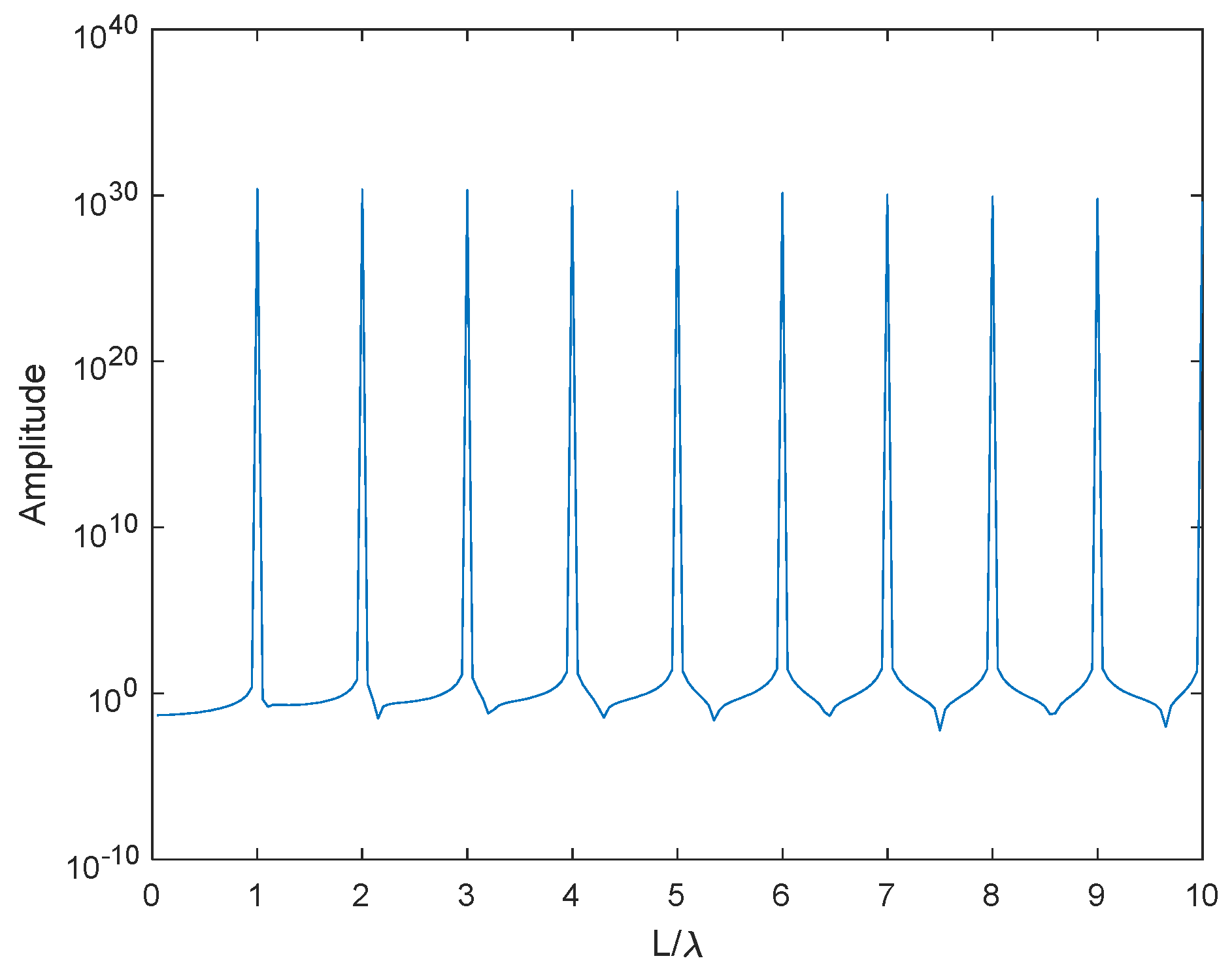


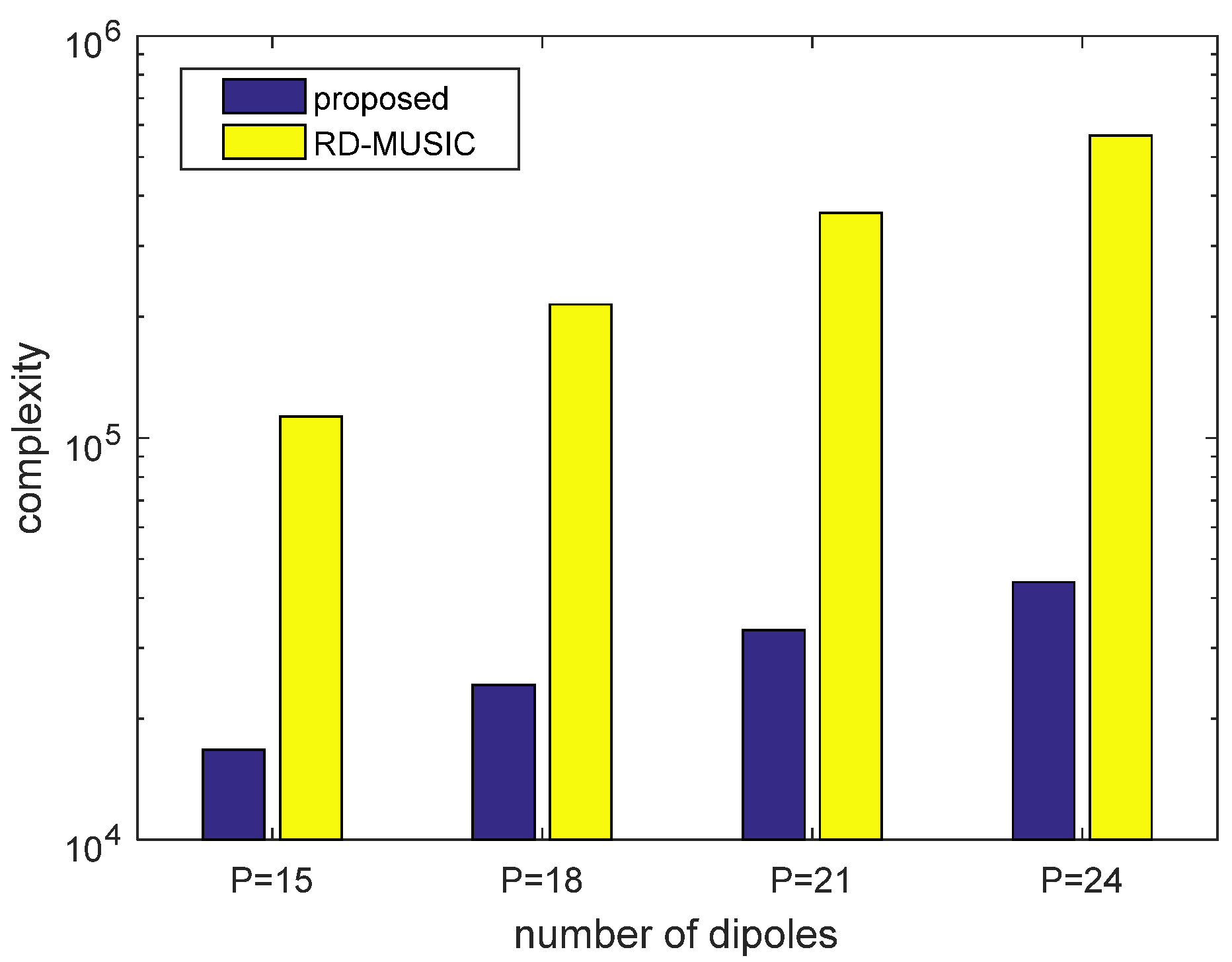
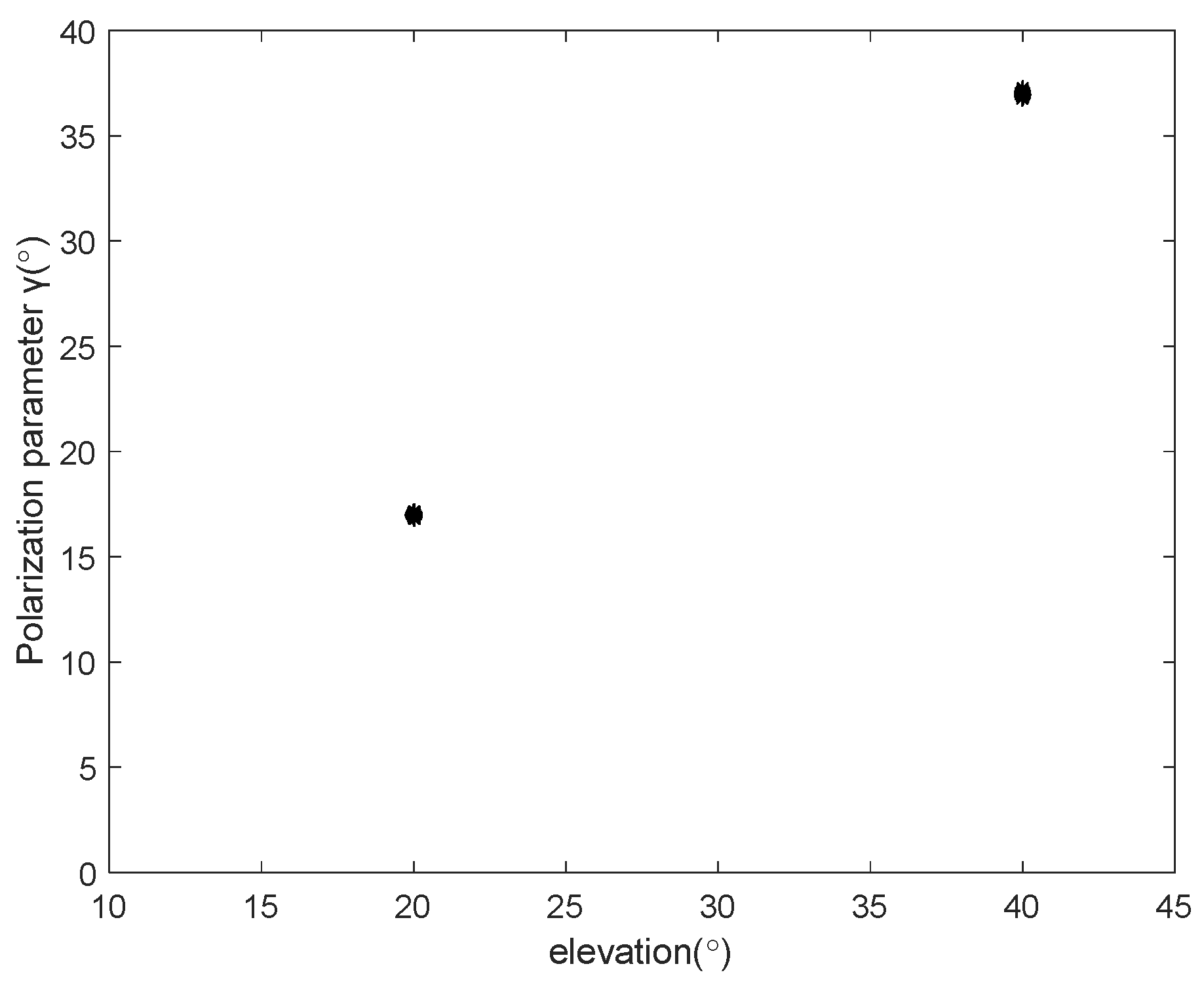


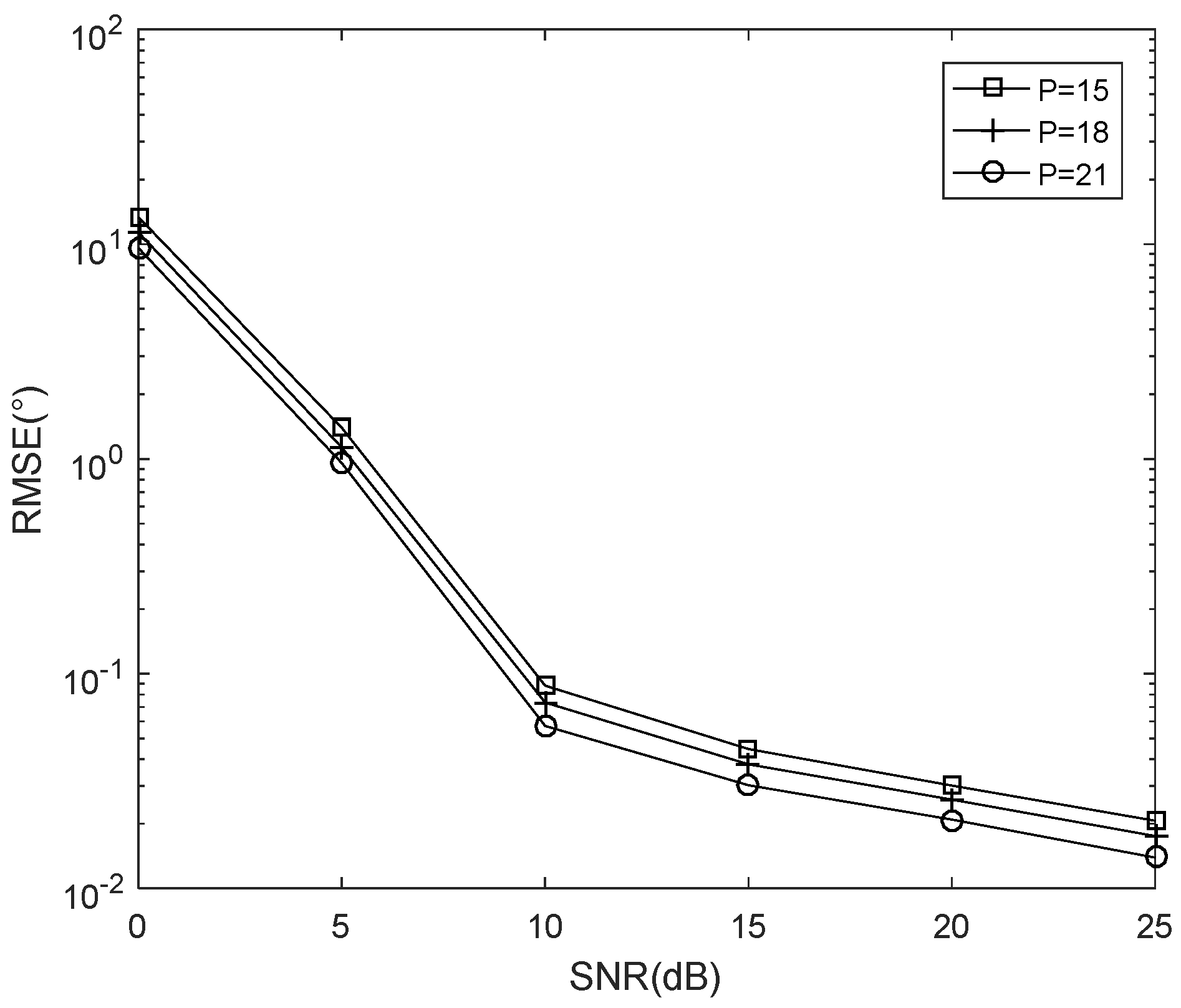


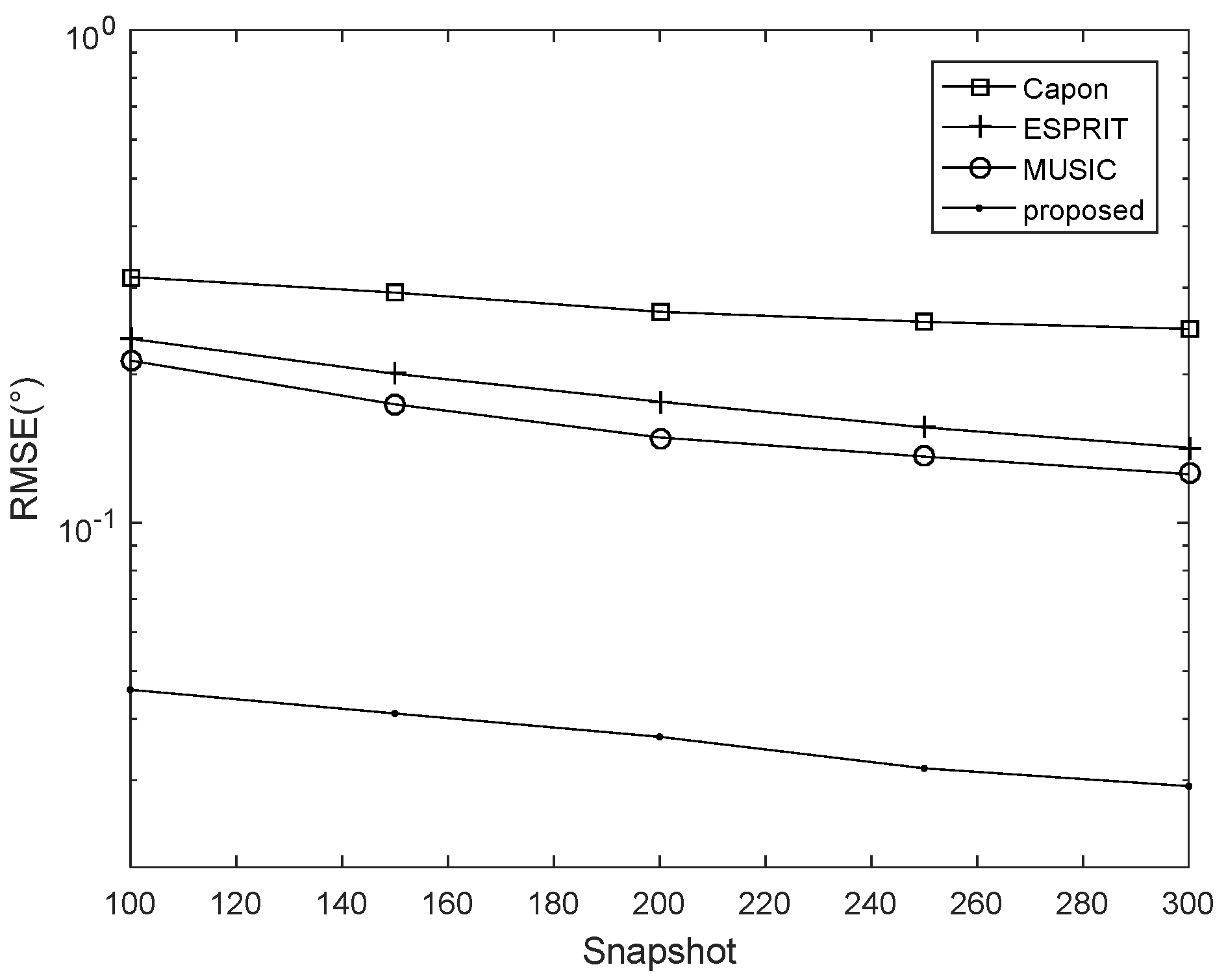



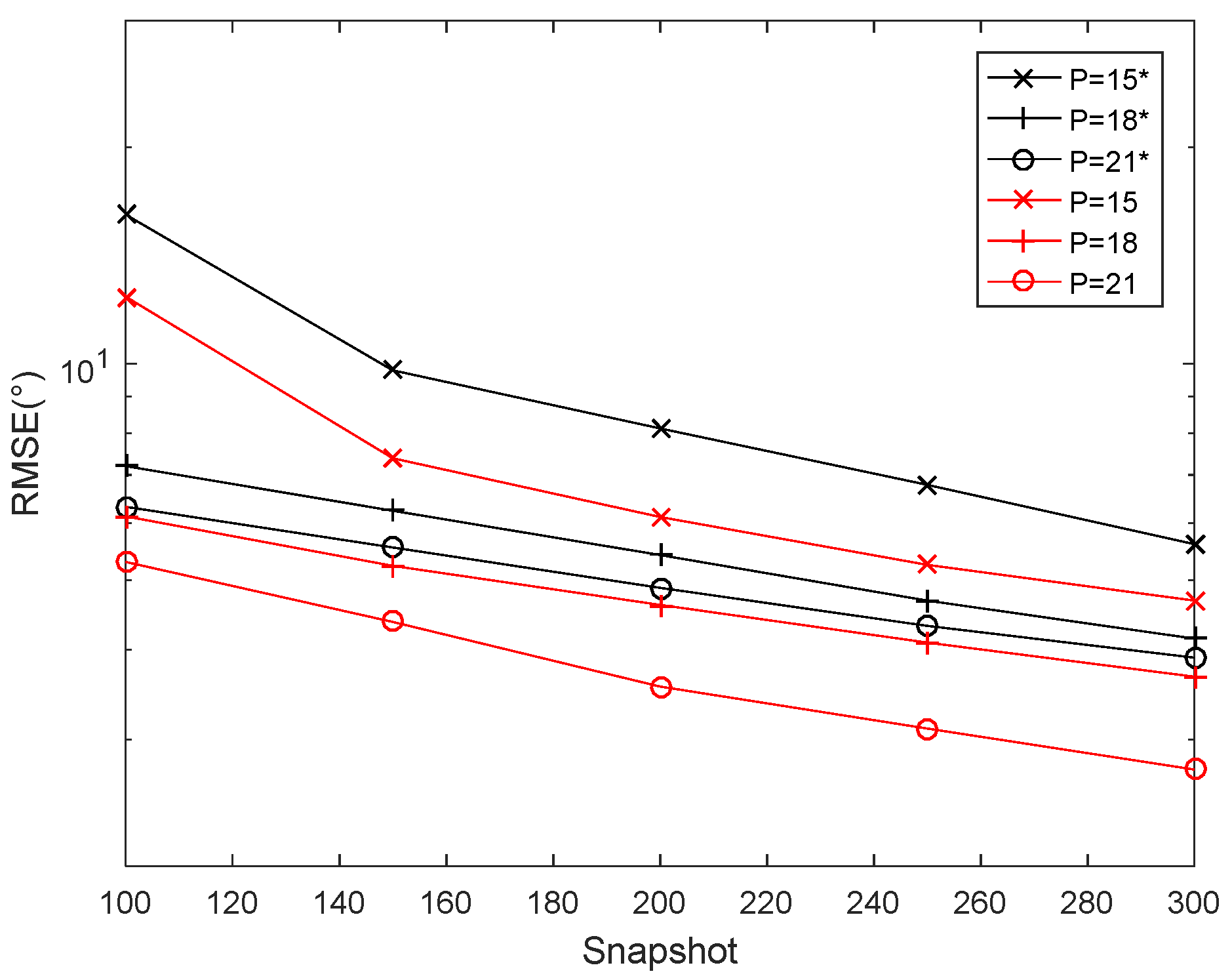
Publisher’s Note: MDPI stays neutral with regard to jurisdictional claims in published maps and institutional affiliations. |
© 2022 by the authors. Licensee MDPI, Basel, Switzerland. This article is an open access article distributed under the terms and conditions of the Creative Commons Attribution (CC BY) license (https://creativecommons.org/licenses/by/4.0/).
Share and Cite
Yang, M.; Yuan, Q.; Lai, X.; Zhu, B.; Zhang, X. Triple Coprime Vector Array for DOA and Polarization Estimation: A Perspective of Mutual Coupling Isolation. Electronics 2022, 11, 4112. https://doi.org/10.3390/electronics11244112
Yang M, Yuan Q, Lai X, Zhu B, Zhang X. Triple Coprime Vector Array for DOA and Polarization Estimation: A Perspective of Mutual Coupling Isolation. Electronics. 2022; 11(24):4112. https://doi.org/10.3390/electronics11244112
Chicago/Turabian StyleYang, Meng, Qi Yuan, Xin Lai, Beizuo Zhu, and Xiaofei Zhang. 2022. "Triple Coprime Vector Array for DOA and Polarization Estimation: A Perspective of Mutual Coupling Isolation" Electronics 11, no. 24: 4112. https://doi.org/10.3390/electronics11244112
APA StyleYang, M., Yuan, Q., Lai, X., Zhu, B., & Zhang, X. (2022). Triple Coprime Vector Array for DOA and Polarization Estimation: A Perspective of Mutual Coupling Isolation. Electronics, 11(24), 4112. https://doi.org/10.3390/electronics11244112







